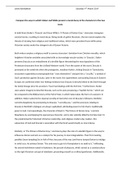Leena Ramlakhan Saturday 9 th March 2019
Compare the ways in which Stoker and Wilde present a moral decay in the characters in the two
texts.
In both Bram Stoker’s ‘Dracula’ and Oscar Wilde’s ‘A Picture of Dorian Gray,’ characters transgress
societal norms, resulting in moral decay. Being works of gothic literature, the two novels explore the
threats of straying from religious and traditional values, which were prevalent fears within pious
Victorian society under the stringent rule of Queen Victoria.
Both writers employ a religious motif to convey characters’ deviation from Christian morality, which
heightens Victorian anxieties associated with an increasingly secular society. In ‘Dracula’, Stoker
presents Dracula as an embodiment of a devilish figure threatening the moral goodness of the
Protestant characters from the civilised Western world. From the outset of the novel, Dracula is
portrayed as the antichrist when the protagonist, Jonathan Harker, visiting Dracula in Transylvania,
encounters superstitious townspeople that “cross themselves” and give him a “crucifix,” a symbol of
God’s protection against Dracula. Later in the novel, the superstitions surrounding Dracula in Eastern
Europe are confirmed when Van Helsing mentions how Dracula is directly linked to the Devil through
his family lineage since his ancestors “have had dealings with the Evil One.” Furthermore, Stoker
uses satanic imagery to describe Dracula, such as his eyes possessing a “basilisk horror,” which can
be compared to the Biblical story of the Fall of Man, in which Satan takes the form of a serpent. In
addition, Stoker subverts the classical worship of God when one of Dracula’s followers, Renfield,
commits blasphemy by proclaiming to Dracula: “I worship you,” and the pronouns relating to
Dracula in Renfield’s dialogue are always capitalised, attributing power to him that is traditionally
given to God. Correspondingly, the character of Basil in ‘The Picture of Dorian Gray,’ commits
blasphemy by worshipping the eponymous character, and is also violently killed by his false God. To
the predominantly Protestant Victorian readership, and religious modern-day readers, this
subversion of God and Dracula’s association with the Devil would classify as moral decay.
Similarly, in ‘The Picture of Dorian Gray,’ Lord Henry plays the role of a devilish figure in the way he
influences Dorian and acts as a catalyst for his journey to moral degradation. Their first meeting
parallels Satan tempting Eve in Fall of Man, because of the way Lord Henry tempts Dorian to indulge
in sinful acts. He advises Dorian: “the only way to get rid of temptation is to yield to it,” infiltrating
his amoral worldview rooted in hedonism, the pursuit of pleasure, which served as a counterculture
to the rigid Victorian concept of dandyism; presenting oneself as a refined gentleman. Additionally,




